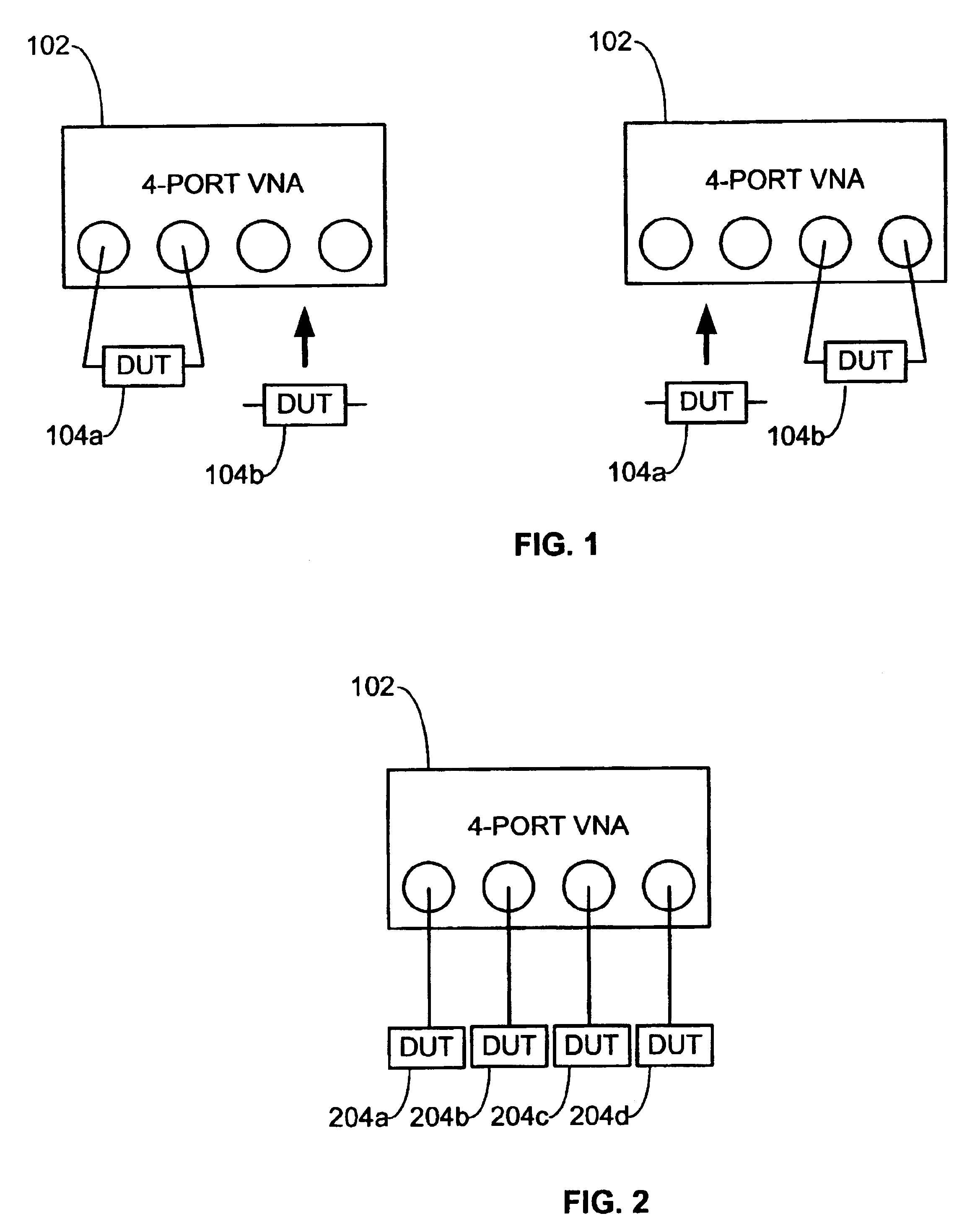Flexible vector network analyzer measurements and calibrations
a vector network analyzer and flexible technology, applied in the direction of instruments, resistance/reactance/impedence, transmission monitoring, etc., can solve the problems of inability to accurately measure the accuracy of vector analyzers, and inevitable hardware imperfections or errors in any vna test system. achieve the effect of increasing efficiency
- Summary
- Abstract
- Description
- Claims
- Application Information
AI Technical Summary
Benefits of technology
Problems solved by technology
Method used
Image
Examples
example # 1
EXAMPLE #1
[0037]In a first example, a 4-port VNA is used to measure a pair of 2-port DUTs. While one is being measured, the next is being loaded in the other position and vice-verse. The user has two options:
[0038]a) A first option is to use two 2-port calibrations and recall a calibration setup between each measurement subgroup. If the handler is roughly as fast as the measurement, this results in lost time since the second device is ready to be measured except its calibration has yet to be recalled.
[0039]b) A second option is to use a 4-port calibration, but now 16 parameters must be measured each time when only 4 are needed. This also results in lost time.
[0040]FIG. 1 illustrates the first example measurement using a 4-port VNA 102. A first 2-port DUT 104a is being measured in FIG. 1, while a second DUT 104b is being moved into position (e.g., by a robotic handler). After the S-parameters are measured for DUT 104a and the corresponding calibration is applied, the calibration info...
example # 3
EXAMPLE #3
[0043]In a third example, a 3-port device includes a 1-port resonator / antenna and a 2-port sub-DUT. If leakage is not of interest, then one would really like to measure only five parameters, not nine (as would be the case with a true 3-port DUT). Again, the idea is to avoid measuring more than is needed.
[0044]FIG. 3 illustrates the third measurement example using a 3-port VNA 302. The DUT 304, which can be, e.g., a front end module for a cell phone, includes a 1-port sub-device 306a (e.g., an antenna) and a 2-port sub-device 306b (e.g., an amplifier path), where the two sub-devices 306a and 306b are not electrically connected together. The external ports may be available, for example, for connecting an external filter. DUT 304 is an example of a package, which to reduce manufacturing costs, includes multiple function blocks that are not electrically connected to one another within the package. Since 1-port sub device 306a is not electrically connected to 2-port sub-device ...
example # 2
TIME SAVINGS EXAMPLE #2
[0063]Measurements reduced by 75% over a full cal with no loss in accuracy. If DUTs are tested four at a time, this would also be the time reduction in a measurement time-limited scenario. If, for example, two DUTs are changed while two are being measured, then the time savings is dependent on handler speed. Suppose the measurement time per parameter is 15 ms and the handler time is 30 ms. Ignoring other overhead, the flexible cal total time would be 30+30=60 ms whereas the old cycle time (not handler limited) was (16*15)+30=270 ms. If the handler time was 100 ms, the flexible cal cycle time (handler limited would be 30+(100−30)+30+(100−30)=200 ms and the old cycle time would be 340 ms (still a 41% savings).
PUM
 Login to View More
Login to View More Abstract
Description
Claims
Application Information
 Login to View More
Login to View More - R&D
- Intellectual Property
- Life Sciences
- Materials
- Tech Scout
- Unparalleled Data Quality
- Higher Quality Content
- 60% Fewer Hallucinations
Browse by: Latest US Patents, China's latest patents, Technical Efficacy Thesaurus, Application Domain, Technology Topic, Popular Technical Reports.
© 2025 PatSnap. All rights reserved.Legal|Privacy policy|Modern Slavery Act Transparency Statement|Sitemap|About US| Contact US: help@patsnap.com



